

 |
||
 |
||
Vol. 6 (2): December 2003 |
Download this page
|
|
Greece / Italy / Madeira / Mauritania & Western Sahara / Turkey
Greece
|
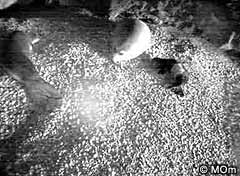 |
|
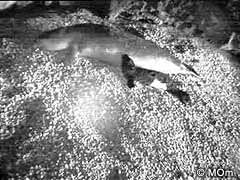 |
|
|
Mother, pup and a third seal (in upper image), captured by video camera in Piperi. |
|
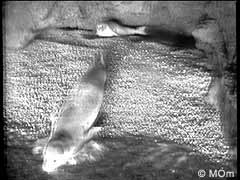 |
|
|
An earlier image captured by the system (at a higher sampling rate) of two seals leaving the Piperi cave. |
A pilot project to install and test a video surveillance system in a monk seal shelter on Piperi is already delivering its first images of a mother and newborn pup.
Piperi forms the core zone of the National Marine Park of Alonissos-Northern Sporades (NMPANS), believed to harbour the largest monk seal population in Mediterranean.
Over the years, scientific monitoring of the species and its habitat by MOm researchers has yielded a considerable amount of biological data on the NMPANS population, as well as more general information on the ecology and behavior of the species. The pilot video monitoring system is expected to contribute substantially to such scientific knowledge, providing a non-invasive method of observation that can yield insights into little-known aspects of monk seal behaviour, including reproduction and mother-pup relations.
In identifying the most suitable shelter to install the system, the research team took 12 years of data on birth cave preferences into account, and also additional information on cave morphology. Piperi is an isolated island with steep, friable cliffs, making the system all the more difficult to install and to protect from the elements. Once all the necessary data had been analysed, however, the final choice of installation site offered several important advantages: during daytime, the cave has adequate natural lighting, making use of the infrared illuminators unnecessary; outside the cave, natural features in the cliff face offered some protection from the worst of the weather for the installation of photovoltaic solar panels, batteries and hard-drive data recorder.
The assembly and installation of the system was completed in early July and quickly commenced its trial operation.
Funds permitting, MOm hopes to deploy a far more advanced, remote-controlled video monitoring system on Piperi next year, designed not only with scientific research in mind but also core zone surveillance and education and public awareness. – Panos Dendrinos, MOm.
MOm’s research team has so far recorded 16 monk seal births during the current 2003-2004 reproduction season in the organisation’s three main study areas.
Four newborn seals have been recorded in the core zone of the National Marine Park of Alonissos-Northern Sporades, 8 in the Kimolos-Polyaigos area and 4 in the area of N. Karpathos-Saria.
Because of stormy weather conditions prevailing during winter, pups may sometimes be swept away or become separated from their mothers. Any member of the public observing a seal in distress should not approach the animal but contact MOm immediately on 210 5222 888. The Rescue Team is on a 24-hour alert in order to provide first aid services to any helpless seal. – Panos Dendrinos, Jeny Androukaki, & Stella Adamantopoulou, MOm.
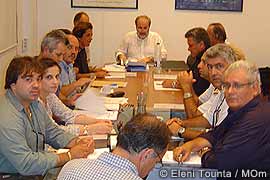 |
|
|
President of the NMPANS, Prof. Nikolaos Delezios (head of table) convenes a historic first meeting of the management authority. |
After a long, 11-year wait, the management authority of the National Marine Park of Alonissos-Northern Sporades finally convened its inaugural meeting on 1 August 2003 at the island’s Biological Research Station at Gerakas. Chaired by its government-appointed President, Professor Nikolaos Delezios of the School of Agricultural Sciences in Volos, the meeting marked the first time that local stakeholders, conservation interests and government officials had gathered to map out the future operation of the Park, and to grapple with serious management issues such as guarding, zonation, fisheries and alternative economic opportunities. If past experience is anything to go by, one of the most serious issues the authority and its President will have to wrestle with will be economic – securing a realistic budget for its own operation.
Monk seal conservation interests are represented on the management authority by MOm, which for many years has played a pivotal role in the operation of the Park, including guarding activities, scientific monitoring of the seal population, rescue and rehabilitation of orphaned seals, and the operation of visitor centres. – Panos Dendrinos, MOm.
Further information
The islands at the end of the line, TMG 4 (2): November 2001.
All at sea – adrift in the Northern Sporades Marine Park, TMG 4 (2): November 2001.
The beginning of the summer period found the MOm Information Centre in Patitiri, Alonnisos freshly renovated and ready to welcome visitors.
The main reception area was rearranged, the walls painted and the lighting of the whole Centre redesigned. Also, the skeleton of a Mediterranean monk seal was reassembled and placed in a 3-D presentation, as well as the skull of a Ziphius cavirostris found in the area in the past. The main overhaul, however, had to do with the texts and the photographs of the information displays, which were enriched, and the setting-up of the interactive game “Illustrious Mastermind”, covering one wall of the Centre. This game poses questions on the Marine Park, the Mediterranean monk seal and the marine ecosystem as a whole, challenging the player to find the correct answer. In this way, both young and older friends of the monk seal have fun learning in an innovative way. – Eleni Tounta, MOm.
As part of its EU-funded LIFE-Nature programme – The Mediterranean monk seal: Conservation Action in two Greek Natura 2000 Sites – MOm has been monitoring and recording human activities in the Kimolos-Polyaigos and N. Karpathos-Saria areas, both of which are important breeding habitats of the species. The aim of the project is to develop a sound monitoring system that can provide reliable data to marine park management bodies on which to base their decisions on such vital matters as guarding and zonation.
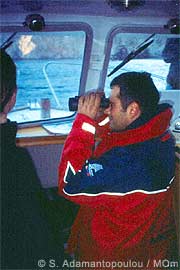 |
|
|
Antonis Sardis, responsible for surveillance on the “Kimolos”. |
MOm has subsequently created an electronic database to record boat traffic and human activities within the areas concerned. In both Kimolos-Polyaigos and N. Karpathos-Saria, activities were recorded from the project’s new surveillance vessels, launched in November last year [see Surveillance systems launched, TMG 6 (1): 2003].
According to data collected in Kimolos-Polyaigos, the surveillance vessel “Kimolos” sailed 127 times, logging 319 hours at sea. During these missions, more than 1,500 boats were recorded in the area, providing evidence of relatively high intensity boat traffic engaged in various activities. Of the total recorded, 43% were pleasure boats, 27% large-scale commercial fishing boats, 22% small-scale subsistence fishing boats, 3% merchant ships, 3% ferry boats and finally less than 1% tourist boats.
In the Karpathos-Saria area, the surveillance vessel “Saria” sailed 99 times, logging 370 hours at sea, during which it recorded 419 boats. The distribution of total boat traffic in this area was considerably different, comprising 11% pleasure boats, 77% large-scale commercial fishing boats, 12% tourist boats and, finally, 1% merchant boats. – Stella Adamantopoulou, MOm.
On World Environment Day, 5th June 2003, the Minister for the Environment, Physical Planning and Public Works announced the formation of the Management Body for Karpathos-Saria, along with 25 other similar authorities to administer some of the most important nature conservation sites in Greece. This represents a major landmark for the future protection of Karpathos-Saria, an important breeding site for the Mediterranean monk seal.
The single objective of the new Management Body – legally, a private, non-profit organisation – is the administration and management of the entire spectrum of protected entities in the Karpathos-Saria area. The ten-member Managing Committee of the Management Body, as defined by the Ministerial Decision, is constituted by representatives of the Ministries of Environment, Agriculture, Development and Merchant Marine, the South Aegean Periphery, the Dodecanese Prefectural Government, the Olympos Municipality, stakeholders representing the productive sectors of the local economy, a local non-governmental organization and a specialist scientist from Aegean University. Michalis Chaniotis, a teacher, was appointed Chairman.
According to law 2742/99, the duties of the Management Body are as follows:
The creation of the Management Body marks the beginning of an integrated and participatory management approach towards conservation of the area’s natural environment.
Although MOm was not selected to participate in the Managing Committee, it will nevertheless seek close cooperation with its members, so that the Committee may benefit from its experience and expertise in marine conservation. – Stella Adamantopoulou, MOm.
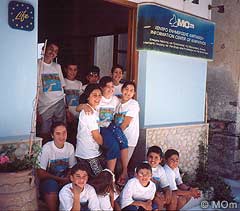 |
|
|
Children of Diafani at MOm’s new Information Centre in Karpathos. |
MOm’s new Information Centre in Karpathos opened its doors on Sunday 29th June with an official ceremony attended by civic leaders and the Chairman of the Karpathos-Saria Management Body, Michalis Chaniotis. The traditional blessing was followed by a welcoming address by MOm and local dignitaries, who once again expressed their commitment to support the conservation actions in the area. Both the Information Centres of Karpathos and Kimolos operated throughout the summer months, welcoming over 3,000 visitors. – Fotini Sfakianaki, MOm.
MOm participated in a workshop that was held on 14-15 November in Istanbul, entitled The Future of Greek-Turkish Civic Dialogue. This forms part of a broader initiative known as the Civil Society Development Program, funded by the European Commission.
Within the context of Turkish-Greek Civic Dialogue, the EC Representation to Turkey and the NGO Support Team organized a series of workshops in order to bring together civic initiatives, local authorities, academics and representatives of the media of both countries.
The NGO Support Team’s objectives are to:
MOm has previously engaged in a government-supported partnership initiative with its monk seal conservation counterpart in Turkey, SAD-AFAG, which consisted of exchange study visits in Alonissos and Foça respectively [see Meeting of minds, TMG 5(1): May 2002]. – Vrassidas Zavras, MOm.
Mediterranean News continues with Italy, Madeira, Mauritania & Western Sahara, and Turkey…
Copyright © 2003 The Monachus Guardian. All Rights Reserved |